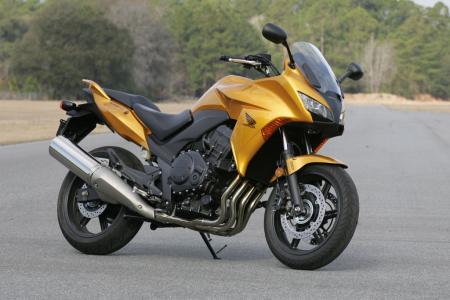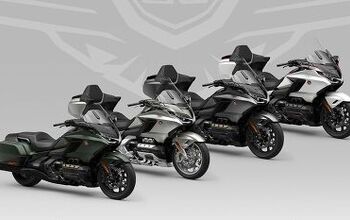2010 Honda CBF1000 Review - Motorcycle.com
While our northern neighbors crave access to the H onda NT700V, a bike that’s not in the Canadian Honda lineup, they do enjoy a host of other models we don’t get stateside. A while back, we reported on the CB1000R, a bike that may be available in Canada soon. This time we bring you a naked bike they do get, the 2010 CBF1000.
There are some things Canadian that you just won’t find anywhere else in North America. We crazy Canucks eat beaver tails (PETA members stand down; they’re not the kind attached to buck-toothed rodents), our parking meters accept Loonies and Toonies, and French Canadians combine fried potatoes, gravy and cheese curds in a delicious concoction called poutine.
Aside from quirky culinary delights and two-tone coins, Canadians also enjoy another North American rarity; a slew of Euro-spec Hondas imported by Honda Canada for Canadian consumption only.
Now, to understand the significance of importing these machines, we must first give some perspective. Canada has a population of 34 million. That’s a few million short of the population of California, and the country’s annual new motorcycle sales are about half those sold in that state—or about one-tenth annual U.S. sales.
To help reduce importing costs—and ultimately the price to consumers—Honda Canada, the Canadian Honda distributor, usually piggybacks Canadian orders to those placed by American Honda.
In 2007 Honda Canada broke from tradition and dealt directly with Japan to import the CBR125R, a model it believed would boost sales to new, young riders. Studies made by the Honda Canada showed that motorcycle consumer trends north of the border mirrored those of Germany—and the CBR125R was very popular in Deutschland. Canadian riders ate up the diminutive CBR, and the entry-level sportbike sold out in its first year.
Riding on the popularity of this exclusive model, the following year Honda Canada imported two more models that were popular with German riders, the Varadero adventure-touring bike and the CBF1000.
Honda Canada gets a redesigned CBF1000 for 2010. The 998cc inline-Four, a detuned version of the ’06-’07 CBR1000RR mill, has been mildly retuned from last year’s CBF with a slight bump in compression ratio and an increase of 9 hp, now rated at 106 crankshaft horsepower.
Revised styling includes a new, frame-mounted half-fairing with a hawk-eye beak that hints at the CBF’s CBR1000RR heritage, and it has a four-position adjustable windscreen. The screen can be lifted or lowered manually by pulling up or pushing down on it. I was able to adjust it while riding, though disclaimers in the owner’s manual clearly state you shouldn’t do this.
Replacing the previous model’s steel frame is a lighter, more rigid aluminum piece, onto which pivots a 41mm telescopic fork and a single-shock swingarm made from rectangular-section steel.
Minimal suspension adjustments include front and rear preload, and added this year is rear rebound adjustability. Suspension settings are on the firm side, which provided exemplary control at the fast, flowing Roebling Road Raceway, where we followed a day of street riding with a day of fast lapping. However, the trade-off of this firm setup is a slightly choppy ride over broken pavement on the street.
High-speed handling at the track was remarkably settled, which came as a surprise after experiencing the bike’s effortless steering on the street. Steering effort was naked-bike light and neutral, and the machine dove to maximum lean and held its line with the determination of an English Pointer.
That neutral steering was in part due to the use of a 160-series rear tire instead of going to a supersport-sized 180 or 190 series, which would have contributed to some steering resistance. Footpeg feelers touched at maximum lean, but nothing else did, not even the centerstand. Of course, stickier rubber than the Bridgestone BT57s will probably allow hard-part-grinding lean angles, but this isn’t a bike aimed at track days.
Its racetrack handling was commendable, but it’s not a point-and-shoot type of bike, and kamikaze-diving to the apex was not its strong point. It weighs a claimed 540 pounds wet, which is 20 pounds less than the ABS-equipped Suzuki Bandit 1250 but a whopping 53 pounds more than the Yamaha FZ1, though the big Fizzer doesn’t have ABS, while the CBF1000 has Honda’s Combined ABS as standard.
Although Europeans have a choice between ABS and non-ABS models, Honda Canada decided to import only the ABS model, which uses two 296mm discs and three-piston calipers up front, while a 240mm disc with a single-piston caliper in the rear contributes to the linked system.
Engine power is more than adequate, though literbike junkies will suffer withdrawal symptoms. The high-rpm, adrenalin-inducing charge of an open-class supersport has been subdued to an entertaining stroll across the rev range. It doesn’t have the Bandit 1250’s brute bottom-end force, but there is more than enough power for everyday chores like commuting or two-up sport touring, with a broad, flat powerband providing buzz-free cruising.
Shifting through the six speeds will put minimal wear on your left boot toe, as gear changes are light and positive, while the moderately light-effort clutch released smoothly with wide engagement.
A comfortably upright riding position reinforced this bike’s all-round demeanor and was unmistakably reminiscent of the once popular UJM. Seat height can be adjusted to three positions from 30.7 to 31.9 inches. I rode the bike in its standard, middle setting (31.3 inches) and had plenty of legroom.
Instruments are attractive yet spartan, with a large central tachometer domineering over two digital displays to either side of it. Aside from the basic speedo, readouts include time, dual tripmeters, fuel level and a fuel economy computer; absent is a gear-position indicator.
Long distances will be easily swallowed up through comfy ergos and very good wind protection, especially with the windscreen in its highest position, and a 5.3-gallon fuel tank will offer a reasonable cruising range.
Honda needs to fortify its line-up with accessible, easy-to-ride machines on which to build a customer base of new riders. Despite this CBF’s ties to the CBR1000RR, it’s not a high-tech, high-performance rocketship; it’s Honda’s modern interpretation of a back-to-basics standard. Honda Canada hopes this machine will have a broader appeal than its supersports and cruisers, and will attract riders that would otherwise look elsewhere for a do-it-all bike.
Related Reading
2010 Honda CB1000R Review
2010 Kawasaki Z1000 Review
2010 Streetfighter Shootout: Kawasaki Z1000 vs. Triumph Speed Triple
2009 Streetfighter Comparison: Ducati Streetfighter vs. Benelli TNT 1130
2010 Honda NT700V vs. Aprilia Mana 850 GT ABS
More by Costa Mouzouris



































Comments
Join the conversation